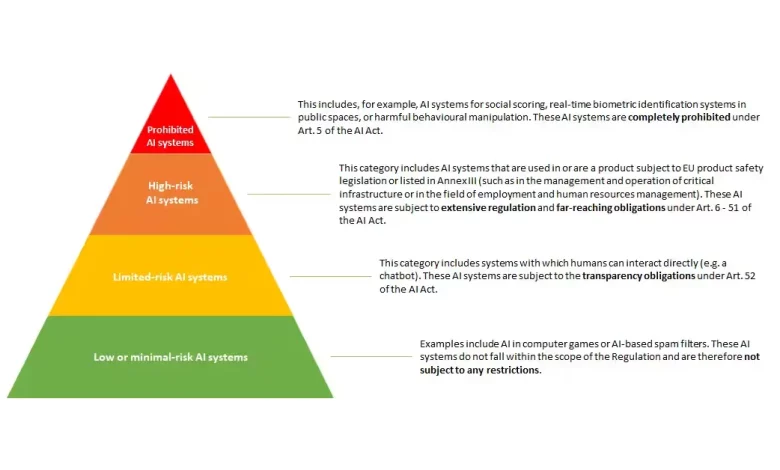Daily Current Affairs for UPSC
European Union Regulatory Framework on Artificial Intelligence
Syllabus- Science and Technology [GS Paper-3]

Context- The world’s first comprehensive laws governing artificial intelligence i.e. The European Union Regulatory Framework on Artificial Intelligence was agreed in a treaty between the European Parliament and EU member states.
Why do we need rules on AI?
- Ethical issues: AI systems can make decisions and actions that affect individuals and society. Establishing rules helps to solve ethical problems in the use of artificial intelligence and ensures that it is compatible with human values and respects fundamental rights.
- Privacy: Artificial intelligence often involves processing large amounts of data. Regulations can help protect an individual’s privacy by determining how information is collected, stored and used.
- Security: Rules are needed to ensure the security of AI systems. This includes protection against potential vulnerabilities and protection against malicious use of artificial intelligence technology.
- Transparency: Regulations can require transparency in AI systems, forcing developers to disclose how their algorithms work.
- Competition and innovation: Creating a regulatory framework creates a level playing field for companies, prevents abuse of dominant positions and encourages responsible innovation.
- Public Safety: Where AI is used in critical sectors such as healthcare, transport or public infrastructure, regulations are necessary to ensure the safety of individuals and the public.
EU framework
- The legislation contains safeguards for the use of AI in the EU, including safeguards for police approval.
- Levels of risk: The regulatory framework imposes obligations on providers and users of services according to four levels of AI risk, viz. unacceptable risk, high risk, limited risk, minimal risk or no risk.
Unacceptable risk
- Unacceptably risky AI systems are systems that are considered dangerous to humans and are banned.
- They include:
- Cognitive behavioral manipulation of people or certain vulnerable groups: for example, voice-controlled toys that encourage children to engage in dangerous behavior.
- Social rating: ranking people according to behavior, socioeconomic status, or personal characteristics
- Real-time and remote biometric identification systems such as facial recognition.
- Exception: Governments can use real-time biometric surveillance in public places only in case of serious threats, such as terrorist attacks.
High risk
- AI systems that negatively affect security or fundamental rights are considered high risk and fall into two categories:
- Artificial intelligence systems used in products covered by EU product safety legislation. This includes toys, aviation, automobiles, medical devices and elevators.
- AI systems that must be registered in the EU database are divided into eight specific areas, including biometric identification and classification of natural persons, management and operation of critical infrastructure, education and training, law enforcement, etc.
- All high-risk AI systems must be evaluated before they are released to the market and also during their life cycle.
Limited risk
- Limited risk AI systems must meet minimum transparency requirements:
- disclose that the content is generated by artificial intelligence,
- By designing the template to prevent the creation of illegal content,
- Summaries of the copyrighted information used in the training will be published.
- User decision-making power: Once the user has interacted with the applications, he can decide whether he wants to continue using it.
- User Awareness: Users should be aware when interacting with AI. This applies to artificial intelligence systems that create or process image, audio or video content, such as deep fakes.
Minimal or no risk
- The proposal allows free use of artificial intelligence with minimal risk.
- This includes applications such as AI-powered video games or spam filters.
What is artificial intelligence (AI)?
- Artificial intelligence is the simulation of human intelligence processes by machines, especially by computer systems.
- AI analyzes large amounts of labeled exercise data to find patterns and correlations.
- It requires special hardware and software, where developers often use popular programming languages such as Python, R, Java, C++ and Julia.
- Artificial intelligence programming focuses on cognitive skills such as learning, reasoning, self-improvement and creativity to achieve specific tasks such as creating new texts, images, music and ideas.
Source: Indian Express
Practice question:
Q. What are the salient features of EU regulation on AI





.png)



